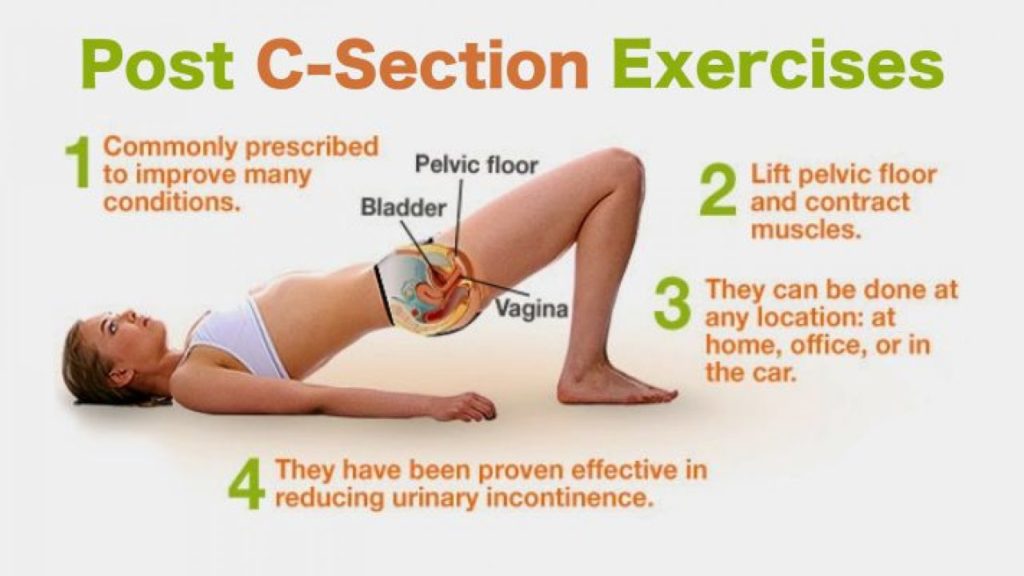C-section is one of the most commonly performed inpatient procedures, and women who require C-section instead of a spontaneous vaginal delivery are at least twice as likely to suffer low back and pelvic pain.
Exercises must be done after cesarean section to strengthen the abdomen and pelvis as well as to combat sagging of the belly. In addition, they also prevent postpartum depression and stress as they help increase mood and energy.
Generally, the exercises can be started from about 6 to 8 weeks after cesarean section, beginning with low impact activities such as walking a short distance.
You can also accompany your new born baby, making the activities more fun and increasing effective bond with the mother.
Physical activities after cesarean section are usually done in two phases, depending on the mother’s condition and as authorised by the doctor.
Exercises for the first 6 weeks
The following exercises should be done in the first six weeks after cesarean section if the doctor allows:
1. Walk
Walking helps the mother feel well and it should be done gradually beginning with short distances such as taking a walk around the block then gradually increasing the distance travelled.
2. Kegel Exercises
Kegel exercises strenghthen the mucles that support the bladder, intestine and uterus and it can be done during pregnancy or postpartum, a few days after cesarean section and after removing the urinary catheter.
3. Exercises for posture
Pregnancy, cesarean section and breastfeeding contribute to poor posture. In the initial phase of postpartum, poor posture can be due to day-to-day activities such as carrying the baby, placing the baby in the crib or breastfeeding; all which can result to back pain.
Exercises such as sitting on a chair with your back straight and shoulders projected back or doing a slight back rotation of the shoulder can be done to avoid back pain and to strengthen the muscles of the abdomen and lumbar. Another exercise associated with breathing that can be done is that while sitting on the chair, inhale and lift the shoulders and lower them when exhaling.
4. Light stretching
Stretching can be done while focusing on the neck, shoulders arms and legs so long as they are light and do not press the scar region of the cesarean section.
Exercises after 6 weeks of cesarean section
There are exercises that can be done at home after medical permission to start physical activity.
These exercises can be done in 3 sets of 20 repetitions about 2 to 3 times in a week. However, it is important not to do heavy exercises like staying in the gym for more than an hour and losing more than 400 calories as this will decrease milk production.
1. Bridge
The bridge is recommended as it strenghthens the muscles of the pelvis, glutes and thigh. It also lengthens and gives stability to the hip.
How to do: Lie on your stomach with your legs and arms outstretched, bend your knees and support your feet on the ground. Contract the muscles of the pelvis and lift the hip off the floor, keeping your hands on the ground for 10 seconds then lower the hip and relax the muscles.
2. Lateral leg lifting
Lifting your legs straight has the advantage of strengthening the abdomen and it also improves posture in addition to avoiding backpain.
How to do it: Lie on your back with your legs and arms straight and without a pillow. Lift as high as you can as you get both legs together, without bending your knees, for 5 seconds, and then lower them slowly.
3. Abdominal light
The mild abdominal is recommended so as to strengthen the tone of the abdomen, improve breathing, prevent back problems and contribute to improvements on day-to-day life.
How to do: Lie on your stomach without a pillow, fold the legs and stretch out your arms. Contract the muscles of the pelvis and lift the trunk as high as you can, looking up for 5 seconds then slowly lowering.
4. Plank on 4 supports
The plank on 4 supports works for the resistance and strenghthening of the abdominal muscles, the pelvic and diafragamation floor and it also improves breathing.
How to do: Support the elbows and knees on the ground as you keep your back straight then contract the belly for 10 seconds. Increase time each week until you reach 1 minute. You can begin with 5 seconds in the first week, then 10 seconds in the second week, 20 seconds in the third week and so on.
Source : zufi.net

